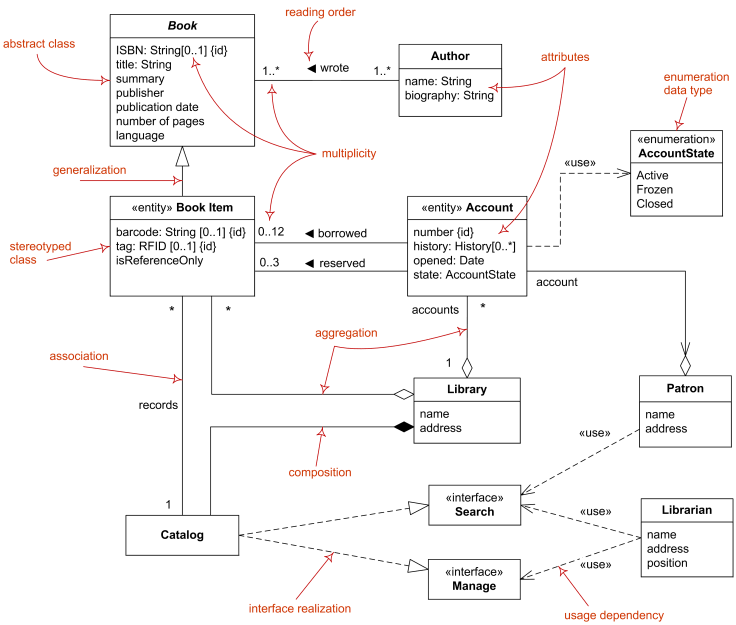UML(統一建模語言,Unified Modeling Language)類圖是一種用於描述系統中各個類別及其關係的圖形表示方法。它是軟體工程中非常重要的工具,幫助開發者理解和設計系統的結構。本文將以一張具體的類圖為案例,詳細解釋UML類圖的關鍵概念。
類圖(Class Diagram)是統一建模語言(UML)中的一種靜態結構圖,用於描述系統的結構。它通過展示系統中的類別、這些類別的屬性、方法以及類別之間的關係,來幫助開發者理解和設計系統的架構。類圖是面向對象建模中的核心工具,廣泛應用於軟體工程中。
UML(統一建模語言,Unified Modeling Language)類圖是一種用於描述系統中各個類別及其關係的圖形表示方法。它是軟體工程中非常重要的工具,幫助開發者理解和設計系統的結構。本文將以一張具體的類圖為案例,詳細解釋UML類圖的關鍵概念。

1. 類別(Class)
類別是UML類圖中的基本單位,代表系統中的一個實體或對象。每個類別通常包含以下幾個部分:
- 類別名稱:位於類別框的最上方,通常以粗體顯示。
- 屬性(Attributes):位於類別名稱下方,描述類別的特性或數據。
- 方法(Methods):位於屬性下方,描述類別的行為或操作。
在這張類圖中,我們可以看到「書籍」、「館藏」、「館藏_書籍關聯」等類別。例如,「書籍」類別包含ISBN、書名、作者等屬性,以及借閱、歸還等方法12.
2. 關聯(Association)
關聯描述了類別之間的結構關係。關聯通常用實線連接兩個類別,並可以在線上標註關聯的名稱和角色。
在這張類圖中,「書籍」和「館藏_書籍關聯」之間的關聯表示一本書可以有多個館藏記錄。這條關聯線上標註了「0..12」,表示一本書最多可以有12個館藏記錄13.
3. 聚合(Aggregation)
聚合是一種特殊的關聯,表示整體和部分的關係。聚合關係用空心菱形表示,連接整體和部分。
在這張類圖中,「館藏」和「館藏_書籍關聯」之間的聚合關係表示一個館藏記錄可以包含多個書籍關聯記錄1.
4. 組合(Composition)
組合是一種更強的聚合關係,表示整體和部分的生命周期是相同的。組合關係用實心菱形表示,連接整體和部分。
在這張類圖中,沒有明顯的組合關係,但如果有,例如「圖書館」和「館藏」之間的關係可以是組合關係,表示圖書館關閉時,所有館藏記錄也將被刪除1.
5. 繼承(Inheritance)
繼承表示類別之間的是否關係,子類別繼承父類別的屬性和方法。繼承關係用空心箭頭表示,從子類別指向父類別。
在這張類圖中,「借閱」和「預約」類別繼承自「操作」類別,表示它們都是操作的一種,並繼承了操作的基本屬性和方法1.
6. 多重性(Multiplicity)
多重性描述了類別之間關聯的數量關係。多重性通常標註在關聯線的兩端,表示一個類別實例可以與多少個另一類別實例關聯。
在這張類圖中,「書籍」和「館藏_書籍關聯」之間的多重性為「0..12」,表示一本書可以有0到12個館藏記錄1.
7. 角色名稱(Role Name)
角色名稱用於描述關聯中的類別在關聯中的角色。角色名稱通常標註在關聯線的末端,靠近類別名稱。
在這張類圖中,「館藏_書籍關聯」類別在與「書籍」關聯時的角色名稱為「館藏_書籍」,表示這個關聯中的書籍角色1.
8. 約束條件(Constraints)
約束條件用於描述類別或關聯的額外限制條件。約束條件通常用花括號「{}」表示,標註在類別或關聯線旁邊。
在這張類圖中,沒有明顯的約束條件,但如果有,例如可以標註「{唯一}」來表示某個屬性必須是唯一的45.
結論
UML類圖是軟體工程中不可或缺的工具,幫助開發者理解和設計系統的結構。通過這張具體的類圖案例,我們可以看到類別、關聯、聚合、組合、繼承、多重性、角色名稱和約束條件等關鍵概念在實際應用中的表現。理解這些概念有助於更好地設計和實現軟體系統167.
Key Concepts of UML Class Diagrams
UML (Unified Modeling Language) class diagrams are a graphical representation used to describe the classes in a system and their relationships. They are a crucial tool in software engineering, helping developers understand and design system structures. This article will use the following class diagram as a case study to explain the key concepts of UML class diagrams.

1. Class
A class is the basic unit in a UML class diagram, representing an entity or object within a system. Each class typically includes the following parts:
- Class Name: Located at the top of the class box, usually in bold.
- Attributes: Located below the class name, describing the properties or data of the class.
- Methods: Located below the attributes, describing the behaviors or operations of the class.
In this class diagram, we see classes such as "Book," "Collection," and "Collection_Book_Association." For example, the "Book" class includes attributes like ISBN, title, and author, along with methods like borrow and return12.
2. Association
An association describes the structural relationship between classes. It is usually represented by a solid line connecting two classes and can include the name and roles of the association.
In this class diagram, the association between "Book" and "Collection_Book_Association" indicates that a book can have multiple collection records. The line is annotated with "0..12," meaning a book can have between 0 and 12 collection records13.
3. Aggregation
Aggregation is a special type of association that represents a whole-part relationship. It is depicted using a hollow diamond connecting the whole to its parts.
In this class diagram, the aggregation between "Collection" and "Collection_Book_Association" indicates that a collection record can contain multiple book association records1.
4. Composition
Composition is a stronger form of aggregation, representing a whole-part relationship where the lifecycle of the parts is tied to the whole. It is depicted using a filled diamond connecting the whole to its parts.
In this class diagram, there is no explicit composition relationship. However, if there were one, for example, between "Library" and "Collection," it would indicate that when the library closes, all collection records would be deleted1.
5. Inheritance
Inheritance represents an "is-a" relationship, where a subclass inherits the attributes and methods of a superclass. It is depicted using a hollow arrow pointing from the subclass to the superclass.
In this class diagram, the classes "Borrow" and "Reserve" inherit from the class "Operation," indicating that they are types of operations and inherit the basic attributes and methods of the "Operation" class1.
6. Multiplicity
Multiplicity describes the number of instances of a class that can be associated with a single instance of another class. It is usually annotated at both ends of the association line.
In this class diagram, the multiplicity between "Book" and "Collection_Book_Association" is "0..12," indicating that a book can have between 0 and 12 collection records1.
7. Role Name
A role name describes the role of a class in an association. It is usually annotated at the end of the association line near the class name.
In this class diagram, the role name for "Collection_Book_Association" in its association with "Book" is "Collection_Book," indicating the role of the book in this association1.
8. Constraints
Constraints describe additional rules or limitations on classes or associations. They are usually enclosed in curly braces "{}" and annotated near the class or association line.
In this class diagram, there are no explicit constraints. However, if there were, for example, a constraint could be "{unique}" to indicate that a certain attribute must be unique45.
Conclusion
UML class diagrams are essential tools in software engineering, helping developers understand and design system structures. Through this specific class diagram example, we can see how concepts such as classes, associations, aggregations, compositions, inheritance, multiplicity, role names, and constraints are applied in practice. Understanding these concepts is crucial for better system design and implementation167.